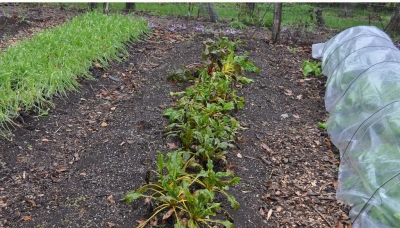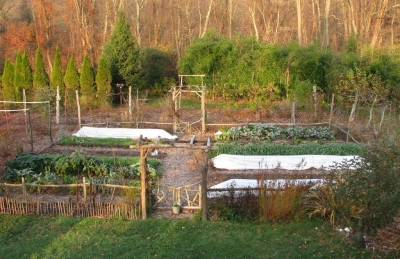THE CLOSING SCENES . . .
In the wee hours of the night of October 12th, temperatures here plummeted to 24°F, and it’s about time. Not that some garden plants wouldn’t have enjoyed a few more weeks of frost-free weather, but in the recent past, that depth of cold would typically arrive on the scene a couple of weeks or more earlier.
So I had plenty of time to prepare everything for the frigid night. Drip irrigation timers, filters, and pressure reducers are safely stowed away in the basement until next April. Frost-tender houseplants are lounging near sunny windows. The extra vents on the greenhouse have been sealed shut for winter. And the near-final cleanup is well underway.
————————————————-
Tidying up the garden is a very satisfying job, especially in a no-till garden like mine. (I detail the benefits of no-till to plants and humans in my book Weedless Gardening, whose title hints at one of those benefits.)
Take the okra bed, for instance, the ground strewn with old leaves above which rose stalky plants capped with a few leaves and an occasional flower or pod. Or the pepper bed. Yesterday it was a jumble of flopped over, old plants still coughing forth a few peppers here and there. Peeking out between the overlapping leaves of the double row of pepper plants was a row of golden beets, planted in spring before the peppers went into the ground.
We cleared the beds by digging around at the base of each plant with a hori-hori knife, a most useful tool that results from the mating of a trowel with a garden knife. With roots cut, the plant is yanked out of the soil and tossed into the garden cart for composting. The comes the finer work. Starting at one end of the bed, we pull each and every weed, roots and all, and pick up every leaf.
What’s left, then, is a smooth expanse of ground, 3 feet wide by 10 or 20 feet long, in the case of my garden beds. The pepper bed is not yet a smooth expanse. Up its center runs that row of golden orbs, each with a dark green, leafy topknot; the spring-planted beets are quite cold-hardy and can remain in place longer.
————————————————-
The thorough cleanup is for more than just aesthetics. Some pests overwinter in old plant debris. Crop rotation, that is, not planting a crop or its kin where it’s been grown for the past 3 years, is one way to move that particular crop away from next year’s potential source of the pest problem (for immobile pests). Thorough cleanup is another way. I opt for both ways.
————————————————-
Cleaning up my bed of crocosmia, a plant with sword-like leaves though which rises an arching stalk of traffic-stopping, orange-red flowers, is for tidiness and for more flowers. Crocosmia was once deemed not hardy here; it was a “summer bulb” planted in spring, flowering in late summer, then dug up a stored until the following spring.
I stopped digging it up each autumn years ago, and these days the plant flowers profusely as early as July. Global warming.
I’ve been digging up crocosmia this week because it grows — and multiplies — too well. The bulbs (actually “corms,” which are underground, thickened stems) have crowded so much that the plants are taking over a corner of the garden. Flowering has suffered. The plants grow mostly leaves.
So I’m digging up every crocosmia corm I can find for replanting somewhere new. I am sure I’ll have missed enough corms so that crocosmia will also appear again in its present location.
————————————————-
The garden looks neater every day. Quoting and agreeing with Charles Dudley Warner, writing in 1898 in My Summer in a Garden, “The closing scenes are not necessarily funereal. A garden should be got ready for winter as well as for summer. When one goes into winter-quarters he wants everything neat and trim . . . so that its last days shall not present a scene of melancholy ruin and decay.”
————————————————-





